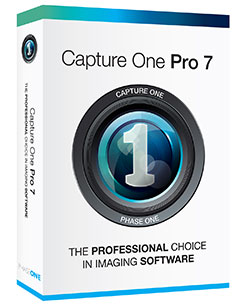Capture One Pro 7

 RAW Image-Editing Software Gets New Processing Engine
RAW Image-Editing Software Gets New Processing Engine
Capture One Pro 7 from Phase One has an improved processing engine with an advanced Bayer Interpolation algorithm, and it comes with integrated digital asset management (DAM). Further improvements include better noise reduction, a new lens setting for tilt-shift lenses, a new Clarity setting for adding punch to photos, new export formats, and more.
I started the review process by importing 4,800 photos from a LaCie 4big RAID 5 connected via a LaCie Thunderbolt/eSATA converter. This setup normally allows a throughput of 200 MB/s, which should be high enough for any digital-imaging software. I first imported these images by simultaneously "ingesting" them in the Capture One catalog with backup enabled.
The import process took the better part of half a day and left the application unresponsive, so I decided to uncheck the backup option. Performance was better, but the application still seemed slower than version 6.
With the catalog only referencing the images already on disk, I got a much snappier performance. Apparently, with images ingested in the catalog, the app needs a lot of processing power and continuously writes to disk. Even 200 MB/s doesn't seem to satisfy Capture One Pro 7's bandwidth hunger.
In my opinion, the DAM module isn't ready for show time yet. Speed is obviously one element. Not having a method to prevent duplicates from ending up in your catalog is another. And what I also would have liked is a search capability across catalogs. Fortunately, you don't have to use the DAM part. You can still use Capture One Pro 7 with a session-based workflow.
While the DAM module was somewhat of a disappointment, the new processing engine turns Capture One Pro into the best of all the RAW image apps available. It combines the power of Aperture (the app I know best) with Nik's latest versions of Viveza and Silver Efex Pro combined.
The new engine is said "to give photographers more detail and better color rendition," but I found that the color rendition looked pretty much unchanged from version 6. I did, however, find that I could better recover highlights and shadow elements with more accuracy than before.
The noise-reduction algorithm has also been considerably improved. I tried it with a photo of a black leather lounge chair and was able to eliminate most of the noise without also wiping out too much of the leather grain.
Lens correction seems to be a big thing in Capture One Pro 7, but it's targeted mainly at users of medium-format cameras, such as Phase One and Hasselblad. Canon and Nikon lenses are also well represented, but my own Zeiss lens by Sony is nowhere to be found.
The best new feature for me is the dramatically expanded Local Adjustments module. Along with the brush mask, you now also get a gradient mask, a brush mask that recognizes area boundaries (auto mask), and a fill mask command.
The Local Adjustment tool lets you play with an image and bring out detail that you can't with other RAW editors, such as Aperture and DxO Optics Pro, unless you use plug-in filters like those from Nik Software.
Other new features included with Capture One Pro 7 (that I couldn't test) are instant tethered capture with Capture Pilot (iOS or Web-browser view and rate functionality), and live view for DSLRs. Version 7 also exports to more formats than before, including JPEG 2000, JPEG XR, calibrated DNG files, and more.
Company:Â Phase One
Price: $299
Web: http://www.phaseone.com
Rating:Â 4
Hot:Â Local adjustments; conversion quality; detail; color
Not:Â DAM module
